The timetable for cleanup of the contaminated Keystone factory site at Raydol Avenue and Humboldt Street will be shortened, said members of the Town Council’s cleanup committee last week.
Chemical injections designed to rid the groundwater of heavy metal contamination put there from when the site contained a metal finishing plant will be done more quickly, officials said.
"The bond passed to pay for the cleanup will be spent in two years instead of five," said Gerald Perricone, who serves as both the town engineer and a representative of PMK – the firm contracted to do the cleanup.
But town officials said residents whose property values might be affected by the contamination should not expect a clean bill of health on the properties sooner. PMK had estimated the cleanup of residential property would take between three to five years, depending on local conditions. Once complete, the state Department of Environmental Protection is supposed to issue each resident a letter to attach to their deeds.
"We’re sticking to the original five year projections for that," said 1st Ward Councilman Christopher Marra, a member of the Cleanup Committee.
History
Keystone has been an issue for more than a decade. The factory closed officially in 1990, when its owner died. In 1991, health officials discovered a significant number of open containers filled with dangerous chemicals. This resulted in a Federal Environmental Protection Agency cleanup. In 1997, however, town officials discovered that contamination in the deeper layers of groundwater had spread off the Keystone factory site and under their homes. After extensive testing paid for by grants from the state Department of Environmental Protection, the town bonded $750,000 to pay to clean up the underground contamination. This involved injection of cleanup chemicals into the ground at various points throughout the neighborhood. The first such injections were done earlier this year.
Perricone said the effect of the chemicals has been "nothing short of spectacular," with a drop in contamination at the worst from 70,000 parts of contamination per billion to less than seven.
Perricone asked the council to allow PMK to use all of the bonded money in two years rather than five, pushing up the deadlines for treatment. Part of the reason is the limited life span of the injected material. Another "blast" now, he said, would likely finish the cleanup process faster than waiting for the five-year period.
"We’re doing this cleanup quicker than we thought we would," Perricone said.
The next cycle of injections was slated to start on Aug. 5 and continue for about two weeks.
"Another hit now should bring the contamination below acceptable levels," he said, and those areas where the contamination remains too high can be treated again later.
"We’ve had better results than we ever imagined from the first injection," he said, noting that as the center or the most contaminated part loses its contamination, it will lessen the impact on residential properties in the area.
This next injection will also address street contamination a few blocks away near the former DPW site on Golden Avenue. The DPW site – although it tested positive last year for other contamination – remains free of the Keystone variety. Perricone’s family owns property adjacent to the DPW site, and his nephew is expected to bid on the property when the site goes up for sale later this year.
Perricone, however, said contamination from the Keystone site has been found in the street near DPW, spread apparently by drainage pipes. This cleanup would be included at no extra charge in the next round of injections, he said, saving the town about $40,000.
Mayor Elwell said the town – which has already established a redevelopment plan for the Keystone site – will likely sell a portion of the property to help fund the $750,000 estimated cost of cleanup.
"The first site we will consider will be the former DPW site," he said.
Two residents in the Keystone cleanup area said they were pleased at the quicker than expected cleanup, but disturbed by the fact that their houses would not receive a clean bill of health from the state for five years.
"I think if they clean it up sooner, we should get a letter from the state sooner," said Barbara Napierski.
Dawn McAdam also expressed some concerns as to why the letter could not be issued sooner.
Councilman Marra said the town intended to stick to its original plan just to be certain about the cleanup.
"We want to be sure this is cleaned up," he said. "While we might be injecting sooner, we still have to test five years to make certain."
